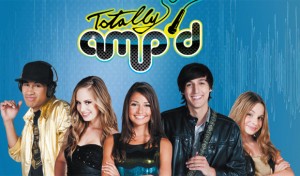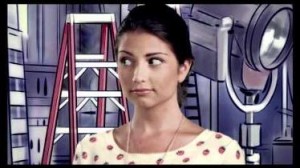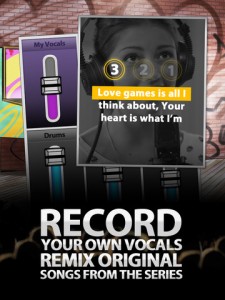
Transmedia case study-Totally Amp’d
By Sheri Candler
To coincide with 2 large events of interest to the cross platform storyteller, London’s Power to the Pixel and Los Angeles’ Storyworld Conference, I wrote up this case study of a cross platform project that was featured on the Storycode site. For the visual learners, there is a video of the presentation at the bottom of post, but it does run over an hour and a half.
Cross platform case study from Canada
Jay Bennett, VP of Digital/Creative Director, Smokebomb Entertainment, Toronto
Project: Totally Amp’d
Totally Amp’d is a mobile-only (Apple devices) series created by Smokebomb Entertainment and the first App of its kind for the underserved tween (ages 8-14) mobile entertainment market. Telling the story of five talented teenagers who are brought together to become the next big pop group, Totally Amp’d comprises a 10-appisode live-action musical comedy series, an original soundtrack, and a suite of interactive activities designed to fully immerse kids in the action.
Intent:
To make an episodic show inside of an app which would incorporate all sorts of interactive elements including music creation, movie editing and fashion design. Also, to experiment with the idea “We are the broadcaster” and see if it is possible to bypass traditional television gatekeepers and connect directly to the audience.
Funding:
Production funding came via the Canadian Media Fund Experimental Stream which supports the creation of innovative, interactive digital media content and software developed for commercial potential by the Canadian media industry or for public use by Canadians. Grant award was less than one million dollars (CAD) of which the video production budget was by far the majority of the budget, around $500K. The app technical development fell between $50-$100K. With an inhouse team this could have been lower, but they used a third party developer.
Audience demographic:
They intended the series to target 8-12 year old girls and focus on music and performance, capturing the American Idol/Glee set. Aim was to create the show for an older girl, a 14 year old, because then the 8-12 year olds will watch.
Background of the team:
Bennett came up through the ranks of digital advertising agencies conceiving and executing ARGs, puzzles and finding code in URLs to tell stories. He disagrees with that approach to storytelling because he sees himself as the average user, not someone used to looking for the magic rabbit hole in a story. He wanted the story to be more accessible through video because it is a medium the average user understands. While he believes that there are opportunities for deeper content, he would rather spend the majority of the budget on video content and much less on puzzles, games, ARG type experiences.
Smokebomb Entertainment is the digital division of Shaftesbury Productions, a leading Canadian TV producer. Totally Amp’d is their first completely original project to launch.
They brought in Karen McClellan as head writer with experience in the children’s TV market as well as writers from from the young adult market to give the scripts a more mature feel. The cast they chose played within a year of their real ages, not having 22 year olds play 17, in order to have more authenticity.
Development phase:
During research, they found a lack of good content apps aimed at the female tween demographic.
Though they started out thinking conventionally ( a webseries with some interactivity as an app), the research showed that most people now have smartphones and tablets or would have them very soon so they decided to take the whole project into the app space and viewable on a mobile device.
They only developed the project for Apple products (iPod touch, iPad, iPhone) because they felt that when people think app, they think Apple iTunes. There was a revenue incentive as well since people expect online content to be free of charge, but they don’t expect all apps to be free and they are used to paying via their iTunes account for music and other downloads. This would alleviate the need to access another way (like via credit card or Paypal) for people to pay.Since music was the major focus of the project, they brought in a professional composer who could create pop music worthy of its own release. Kids would know if they were being given “adult” music masking as teen pop and they wanted the music to be a revenue generator so it had to be top notch.
Also, they brought in a production designer to give the set a look that would be remarkable on a small screen. The result looked half real life, half cartoon, a bit like rotoscope. Elements of the set were painted on real glass plates that cost about
$2400 a piece to create, though much of the time they ended up using green screen and VFX which was even more expensive.
Thinking through each component of the app:
This an episodic show about the musical arts so possible elements to include would be music, music videos, fashion, community where kids could discuss the content together, an avatar to use in the community, game to build up points within the community, unique production design that would make the project stand out and sharability on social platforms.
But legal concerns got in the way of building a community forum because legally they needed a moderation team, especially for kids. Big broadcasters have this, but if you don’t have that support (YOU are the broadcaster, remember?), do you have the resources to do it? Also, the avatar idea was dropped because of the cost of building an avatar generating system, the game idea was dropped due to budget concerns and as was social sharing because of deadline issues and the ability of the app to handle pushing out that size of a file to a Facebook or Twitter page. Dropping social sharing was probably a mistake when it came to promotion.
Typical shoot for the video episodes:
6 days, 16 cast members, 72 shooting pages, 58 minutes of content, 10 episodes with an average of 5 minutes per episode, 2 RED cameras, 7 music videos.
The App
They intentionally tried to keep the app simple to use due to budget constraints and due to the age of the audience who could be as young as 5 years old. They needed something very intuitive. The app encompassed both the episodes and the activities. At the end of each episode, a new piece of video content would unlock.
There is a music studio with all the songs from the episode. One could remix the songs with a choice of different instruments, save the creations and play them back, record your own voice singing the songs so you could be the star.
There is a video studio for the music videos. There are 3 screens showing different camera angles of a video and the viewer can edit them however they want. Editing was just a series of touching the screen and the app would remember the sequence and play it back.
Finally, the design studio for the fashions. Viewer is given the blank outline of the outfit and given a choice of material patterns, colors, decorations then dress the characters from the show, a la digital paper dolls, and put them in a scene background from the show. The creations can be saved and turned into wallpapers, screen savers etc.
Deployment strategy
With file sizes like this, wifi connection is a necessity. Although putting the whole app out at once would be a huge download issue, the team thought making kids wait episode by episode would tax their patience. The file size was one gigbyte, about a 20-30 minute wait for download on iTunes.
They put out the first episode for free on Youtube, but to get the whole package, the viewer had to pay one price and it opened the whole app with all of the episodes and special content.
Deciding on a price point
Free was out of the question and 99 cents still felt like free. It would be difficult to raise the price if it started at 99 cents. For an hour’s worth of content plus the extra material, the price they settled on was $4.99. That is the median price to rent a movie on iTunes and so it would be a comfortable price point for most consumers.
Building the Audience
There was a 2 prong strategy; getting attention from the industry/technology audience and from kids/parents of kids who would actually use the app. Parents often browse the app store looking for interesting content for their kids. Since Smokebomb was the broadcaster, they had to be the promoter too.
For industry attention, they used the in house Shaftesbury Media publicity department. In the US, they used a company called One PR.
They received lots of coverage from industry press and business press.
For kids/parents attention, they enlisted the help of mommy bloggers. They did a press junket for a group of 8 influential mommy bloggers to come to Toronto to watch a shoot, see the making of the videos etc. This cost about $15000, but in hindsight they would have bought Facebook ads instead. Not that the goodwill hurt, but to spend that money to get these people to write reviews, it is likely they would have written about it for free just like any other journalist.
For social media interaction they worked with Fisheye Corporation. Tools they utilized included Facebook, Twitter, Tumblr, Youtube, own website with videos and contests.
Created 73 video assets of behind the scenes of production in order to get viewers to know the characters more intimately with backstories and explanations on using the app and what the show would be like. This was slowly dripped out in the lead up to launch.
The team released iPhone recorded videos of music recording sessions, dance rehearsals, cast doing demos of the app to show how it worked. Prize giveaways consisted of asking viewers to record themselves singing one of the songs and uploading it to the Facebook page for a chance to win. They Livestreamed the launch party on Facebook so the audience could join in and people could ask questions with the cast standing in front of the camera to answer. A street team was deployed at local pop concerts happening in Toronto with flyers promoting the show. This was all done in the lead up to launch day in order to build up audience anticipation.
Partnered with Wattpad, a young adult fiction site where amateur writers upload their stories without pay, but some writers have millions and millions of followers. They worked with 5 of the most popular writers and gave each a character from the story and had them write a backstory that did not previously exist. All the backstories led up to the first episode the viewer would see.
They promoted it on Wattpad with character videos explaining what the app was, encouraging viewers to read the backstory on Wattpad, and promoting the launch date and Facebook page.
Deployment implementation
Episode one was released for free on Youtube on Christmas Day. They released lots of teaser clips in the lead up to the first episode release. The clips were featured on AOL Kids which helped the episode reach 320K views. Official launch was January 26, 2012.
There is a risk with doing this. If the audience doesn’t like the first episode, you’ve lost them forever.
Successes
-the project actually launched, and on time
-strong press and critical praise
-industry praise from broadcasters at MIPCOM who said they beat Disney and Nickelodeon to the punch
-Disney wanted to buy the app, but Smokebomb said no because when that offer came, the project hadn’t launched yet and they wanted to see it through. Also, they would have to get agreement from each department head involved at Disney (broadcast, interactive, music etc) and that is very arduous and would take another year to sort out. Also, Disney would own it, there is no revenue share with them. In other words, you get one check and any revenue success Disney has on it (or lack thereof) belongs to Disney.
-launched to great success with fans asking for more! This was a mixed blessing because there wasn’t anything else being created in the immediate future.
Lessons learned
–Danger of the all at once release strategy
After 3 hours, the viewers had burned through all the content and wanted more. The danger in allowing binge viewing is all the build up dissipates in a short amount of time. If they had dripped out the episodes, which they hadn’t wanted to do because they felt the audience wouldn’t be patient, then they could have done more to stoke up the conversations in between episode releases and that would have taken 10 weeks to do, instead of 3 hours. As it was, the audience ate up all the episodes and then were gone to the next thing.
–Danger of the file size
Since the app was 1 gig and had a 30 minute download time, some may have given up before the download finished.
–Being the megaphone
In doing this without a broadcaster’s support, it is exceedingly difficult to reach millions and millions of people on your own, only a fraction of whom will actually buy and download. Undeniably, once the initial launch efforts were finished, the download count dropped. People are still downloading, but nowhere near what they were at the start. This is all down to having a strong and sustained publicity effort going. Once the promotional budget was spent and efforts ceased, the buying went down.
–Selling the rights in other territories
[editor’s note: I know many creators count on the revenue stream they are sure to get from broadcasters/distributors] No broadcaster cares about buying the rights to 10 episodes of a webseries. They will only get 10 weeks out of it on TV and then the show is finished. They don’t want to work at building an audience for only 10 episodes, they want 100 episodes. Same for selling broadcast TV syndication, you can’t sell a show with less than 3 seasons.
Axing the social sharing capability
By axing the social sharing due to budget, they also disabled the ability for free messaging by the viewers to spread their efforts wider. The purpose of social networking is sharing content you are excited about and they didn’t enable an easy way to do that. People did find a way around it, but it could have been done more easily.
Next steps based on those lessons
-Perhaps strip out the episodes and put them online for free to build the widest audience possible. Once you have that large audience, find opportunities to sell either advertising or to a broadcaster who will commission more episodes. [editors note: while this theoretically could work, many, many Youtube channels are already devoted to doing this and very few have accomplished it].
-Perhaps keep the interactivity portions to sell as an app, making the app shorter to download and cheaper, like 99 cents. With many more people watching, it is a much bigger pool of people to ask to buy a 99 cent download app.
-Extend the experience without making new content, new shows, because the production fund is spent so there is no money to make anything new. Perhaps they could build a website as a portal to discovery of other content already available online. Examples: existing unknown bands with the same music sensibility as the show and highlighting them; calls for UGC content as well.
-Look at this project as a pilot for TV or web series for a broadcaster. Truthfully, broadcasting is still where the audience is in a mass way. Are there viral hits on Youtube, yes a few, but the mass audience isn’t consistently on Youtube yet. The ultimate goal is TV, mobile, games, live event, the whole package.
Questions to consider
-How do you create an app that massively catches on when tons of people are creating new things and uploading them every day?
-Once your app is found, how do you keep people engaged from week to week? What mechanisms are you creating to keep your project top of mind?
Thanks to Jay Bennett for being candid about Smokebomb’s process and outcomes. For the video of his presentation including the post Q&A session, watch this
Sheri Candler October 16th, 2012
Posted In: transmedia
Tags: American Idol, app, Apple, ARG, audience building, Canadian Media Fund, Glee, iPad app, Jay Bennett, Power to the Pixel, Shaftesbury Productions, Storycode, Storyworld Conference, Totally Amp'd



